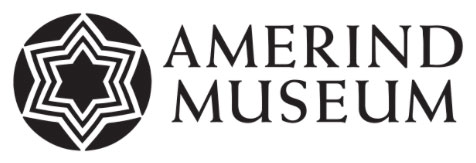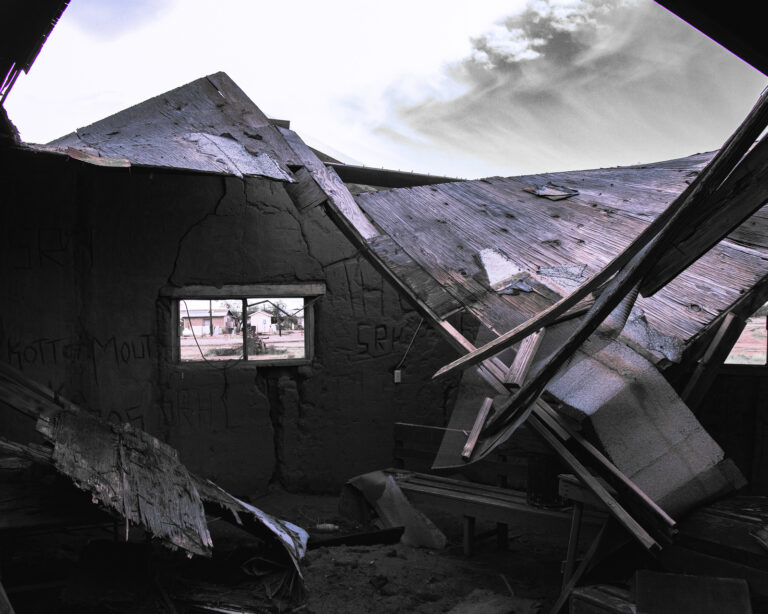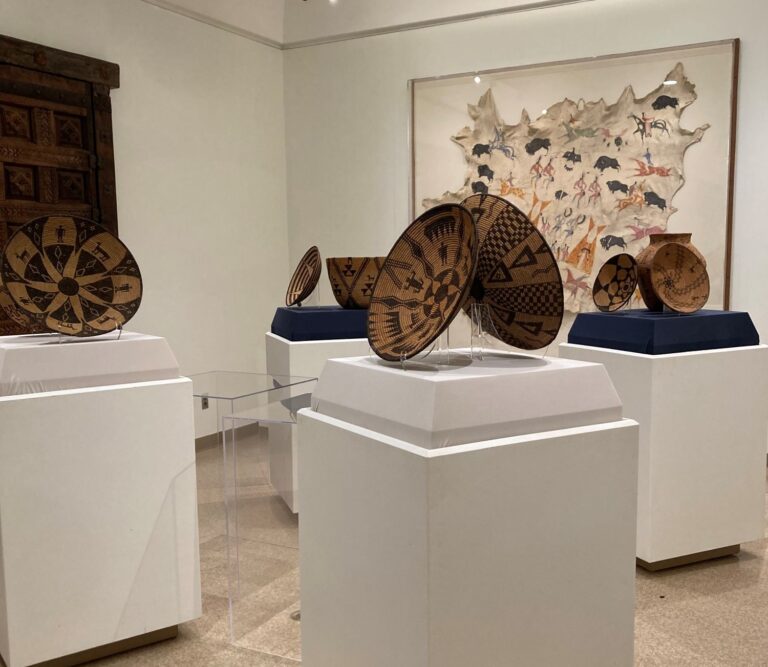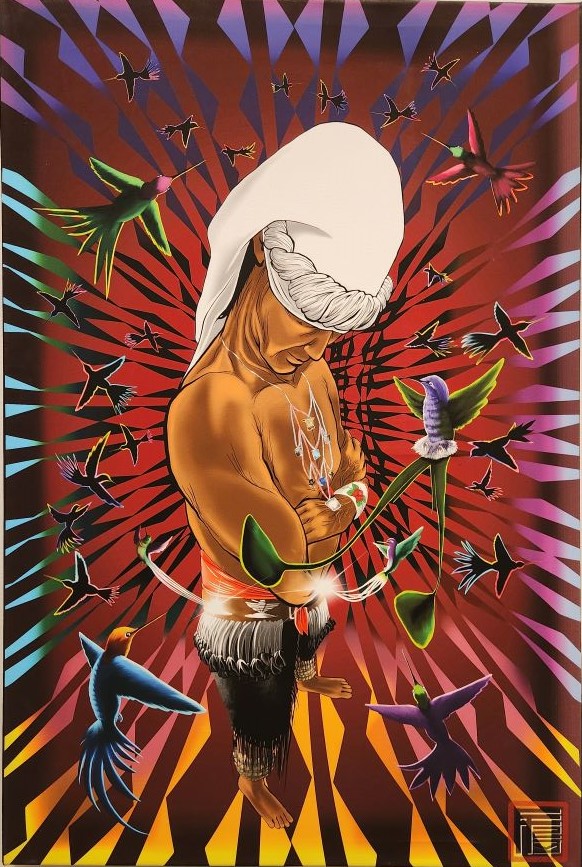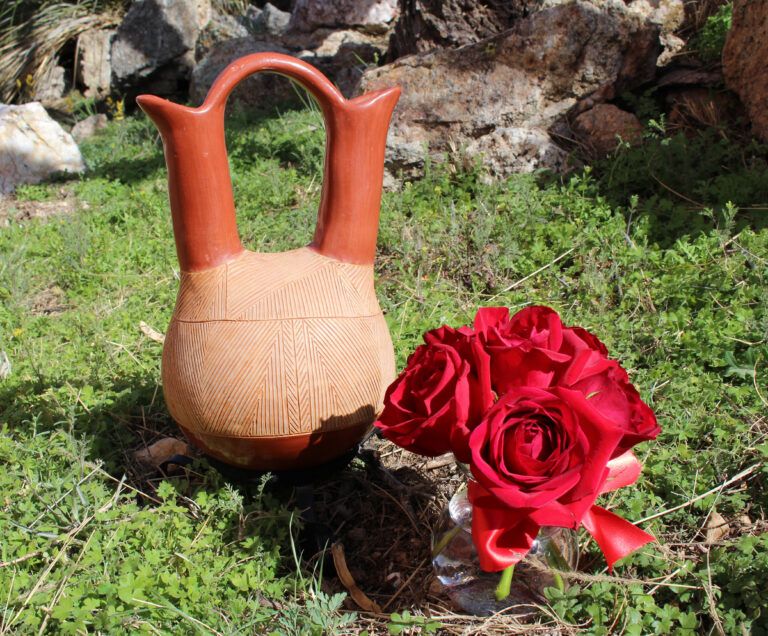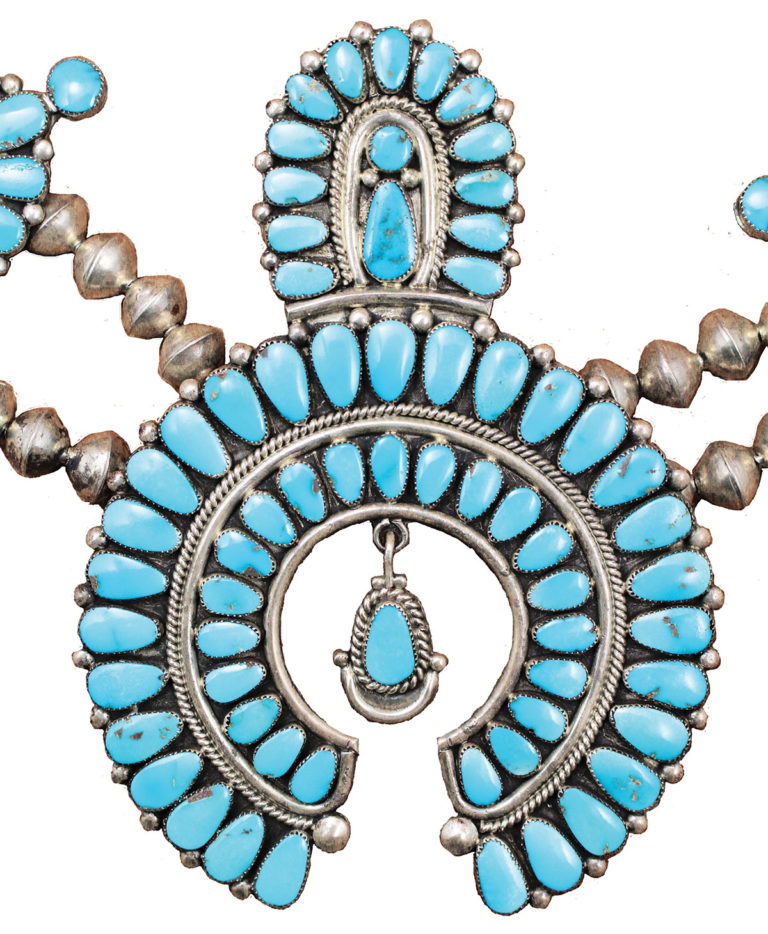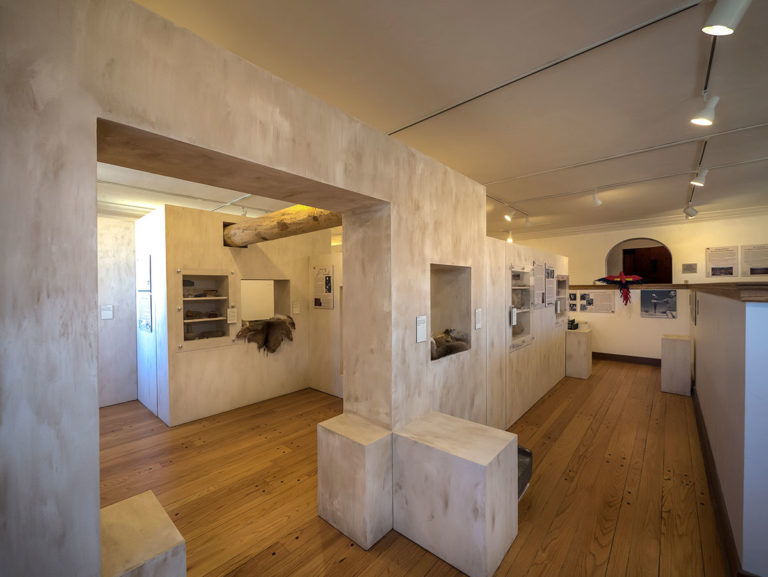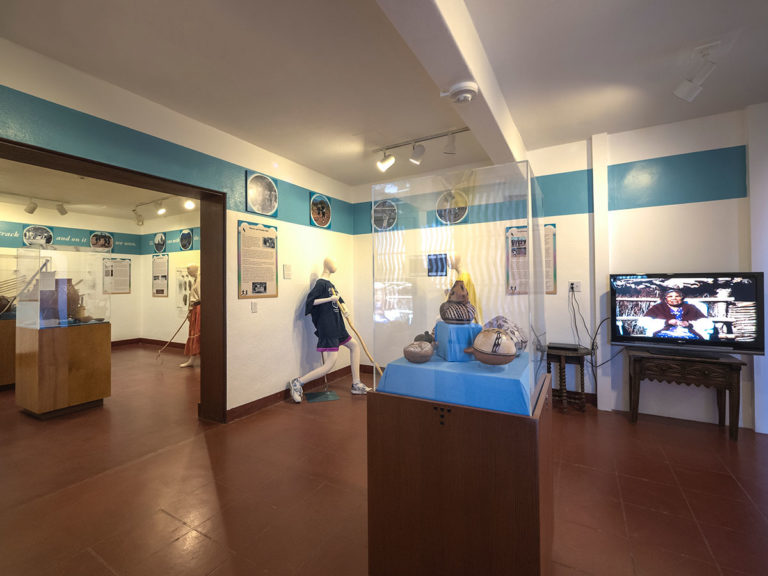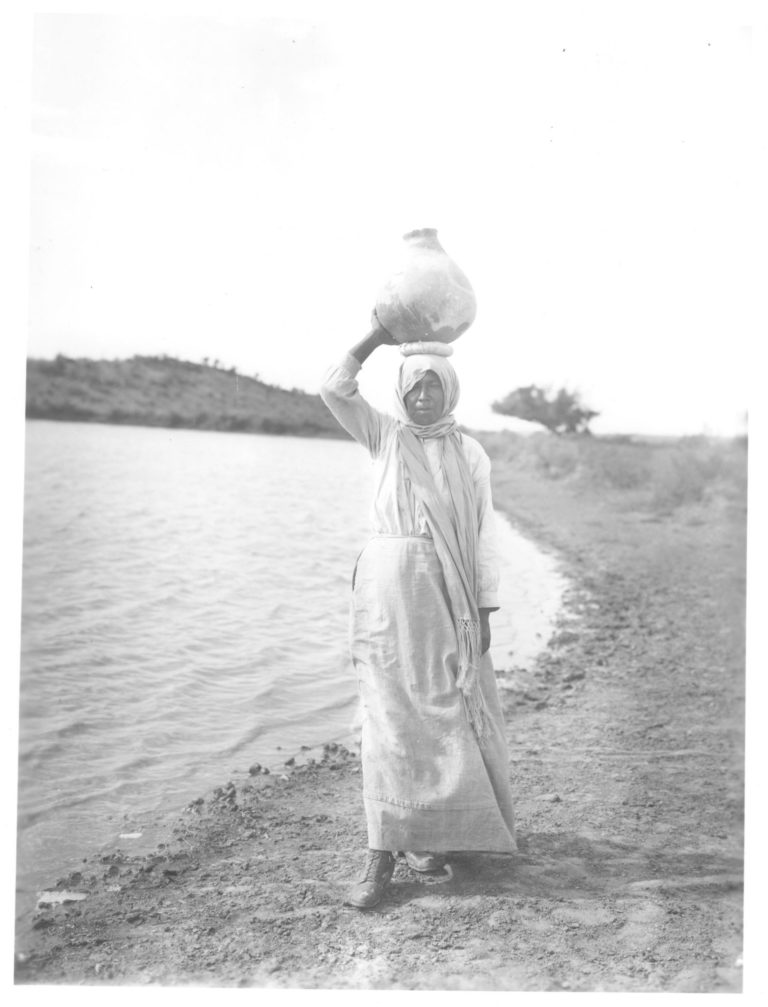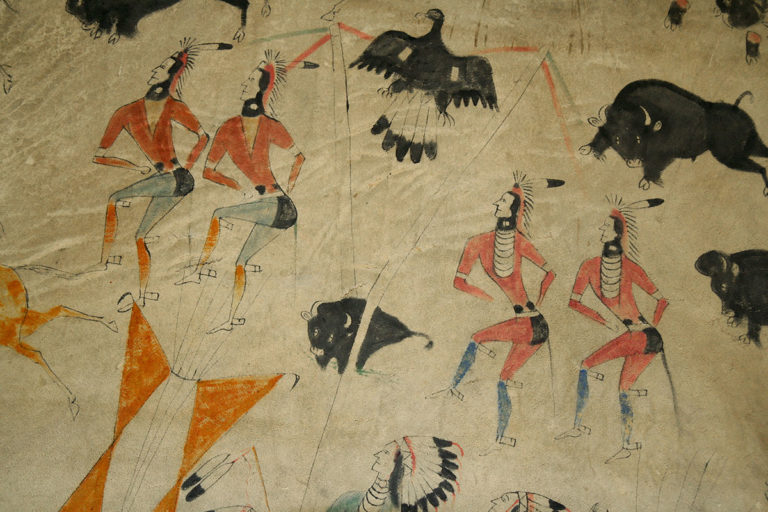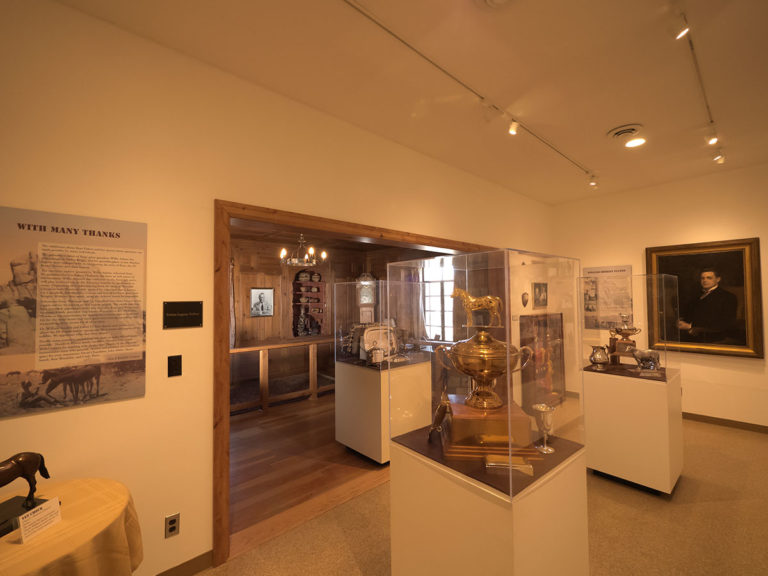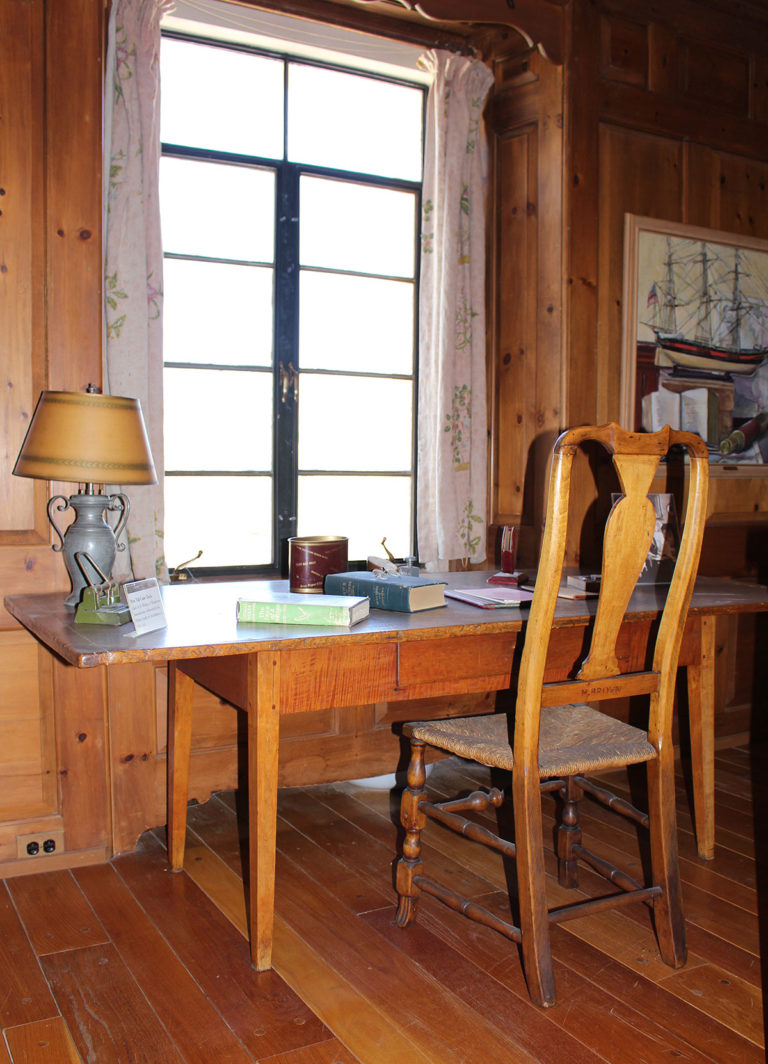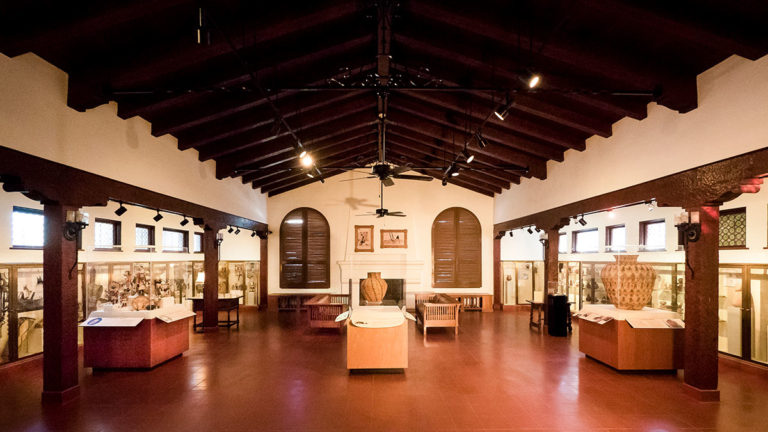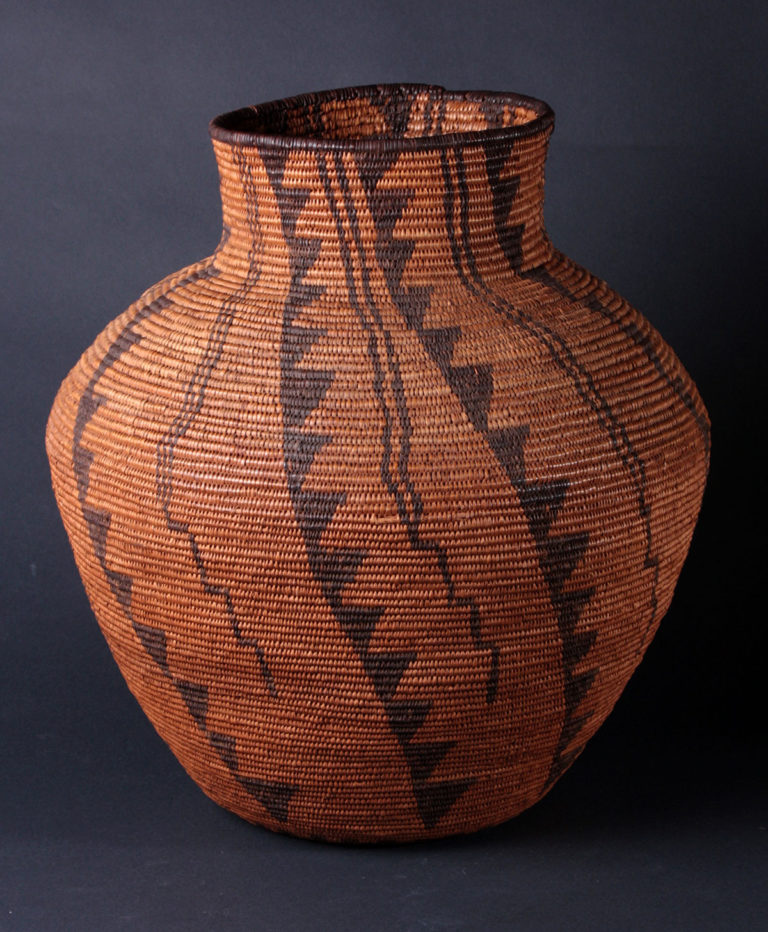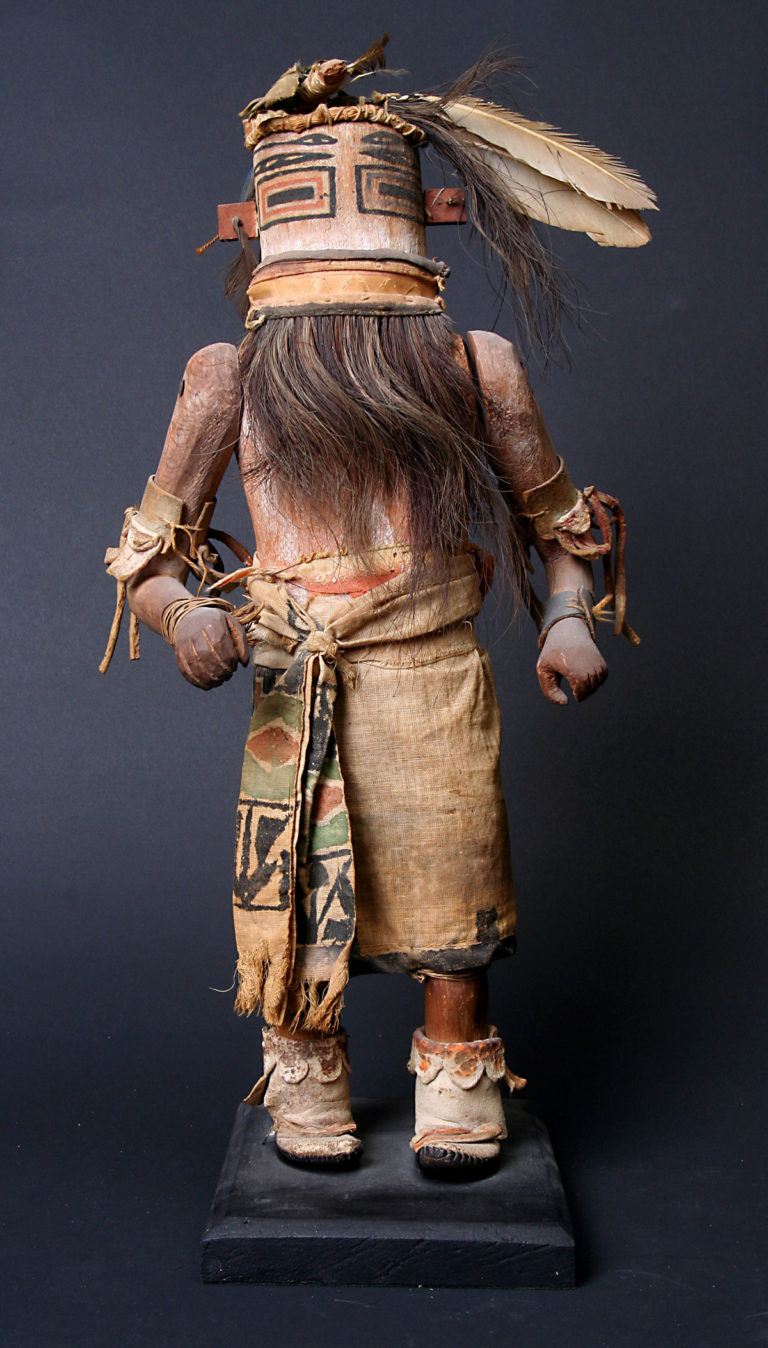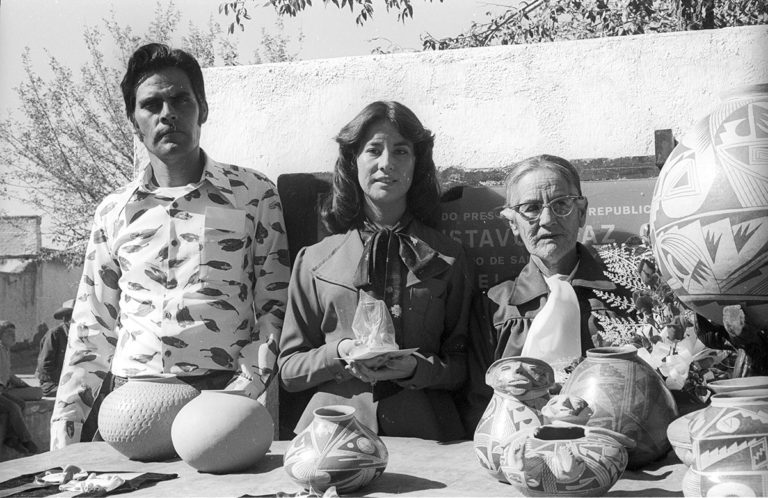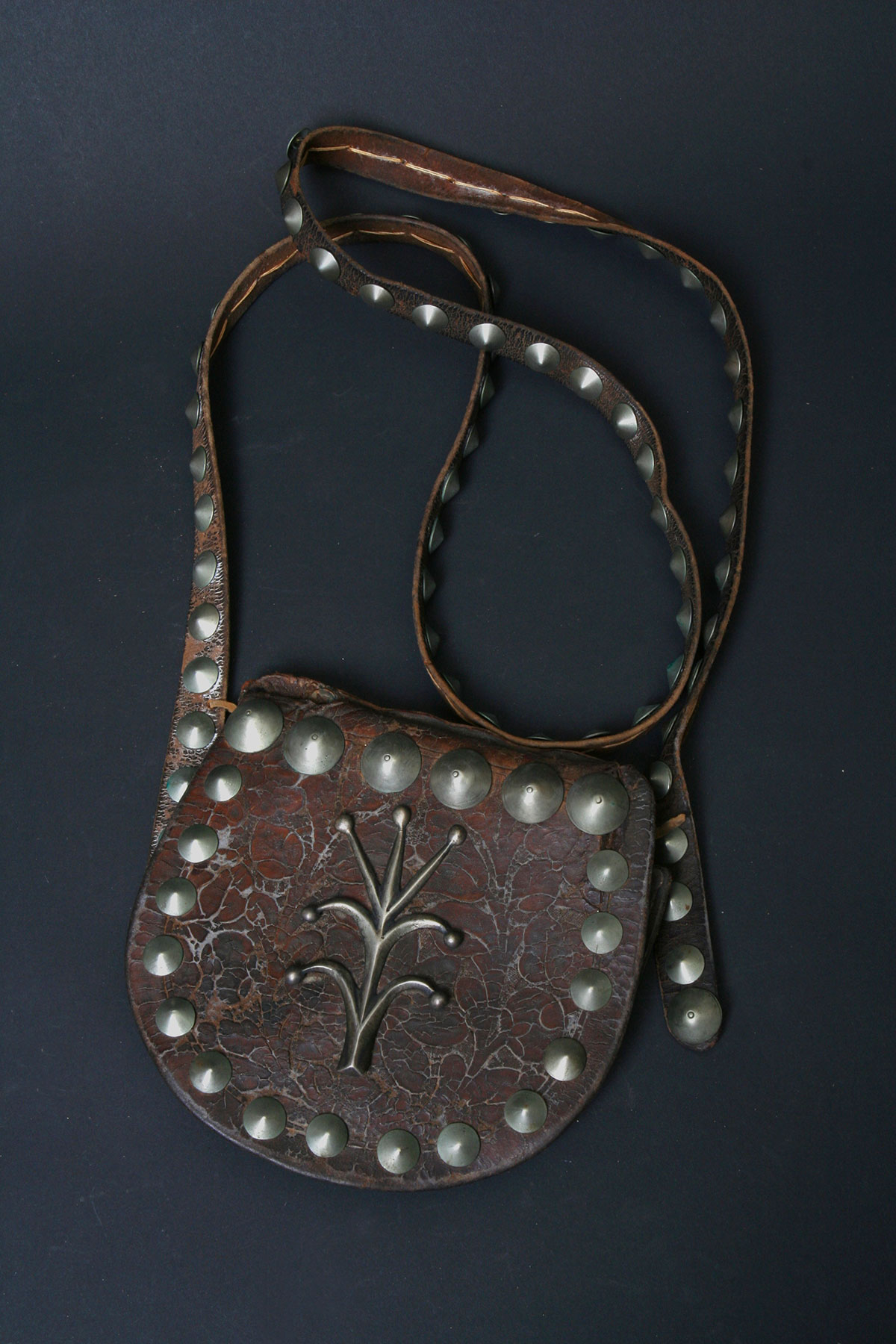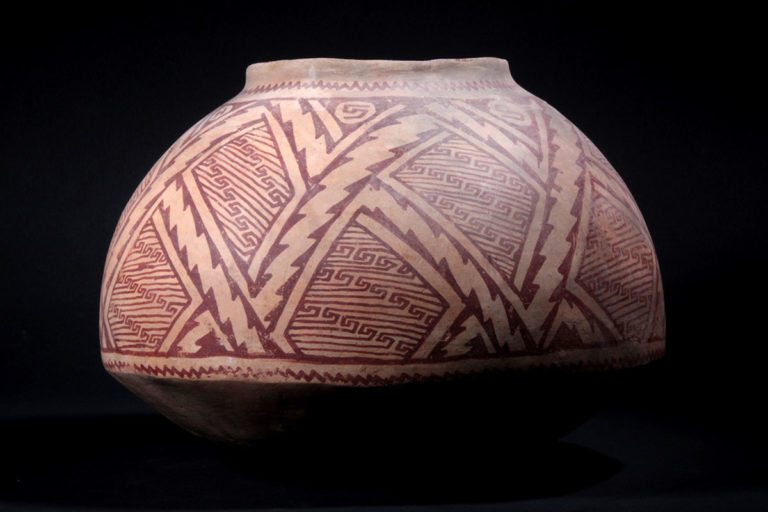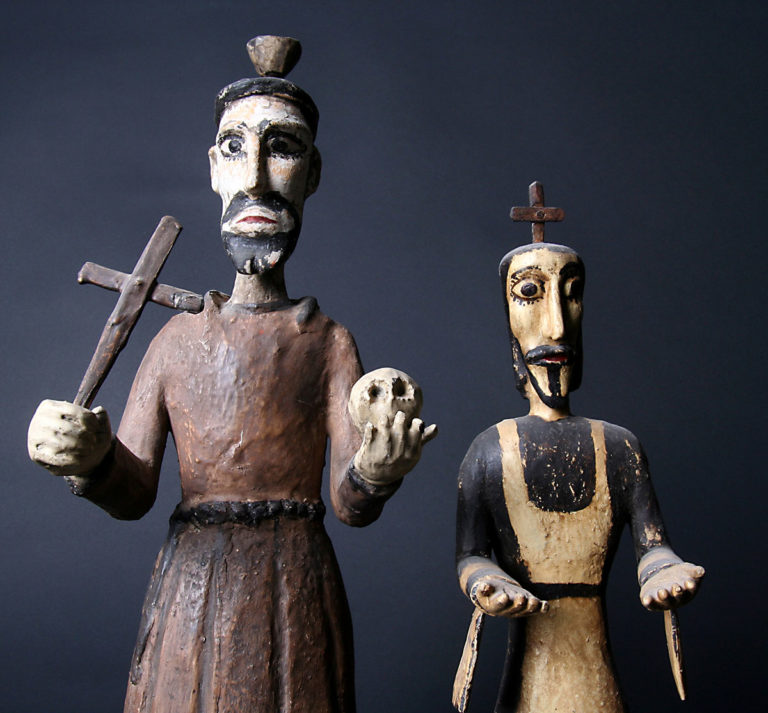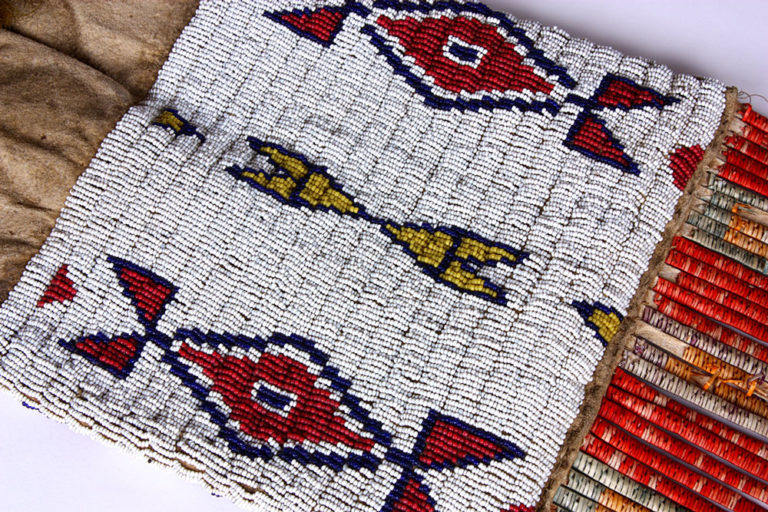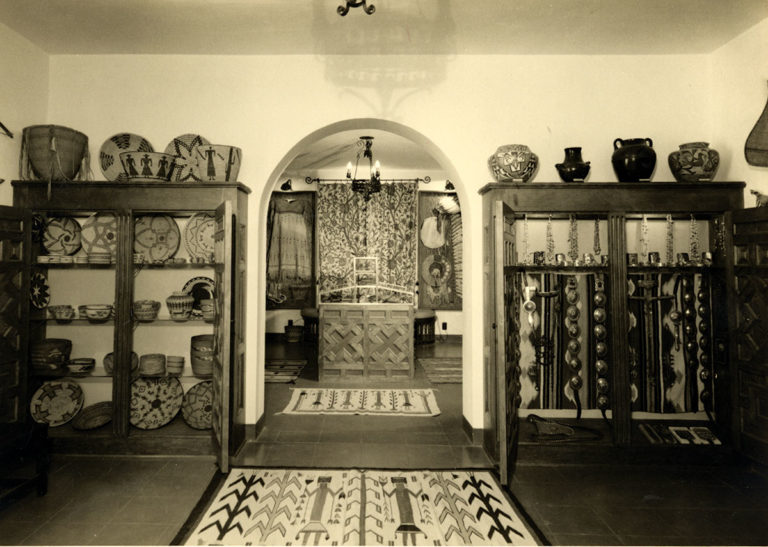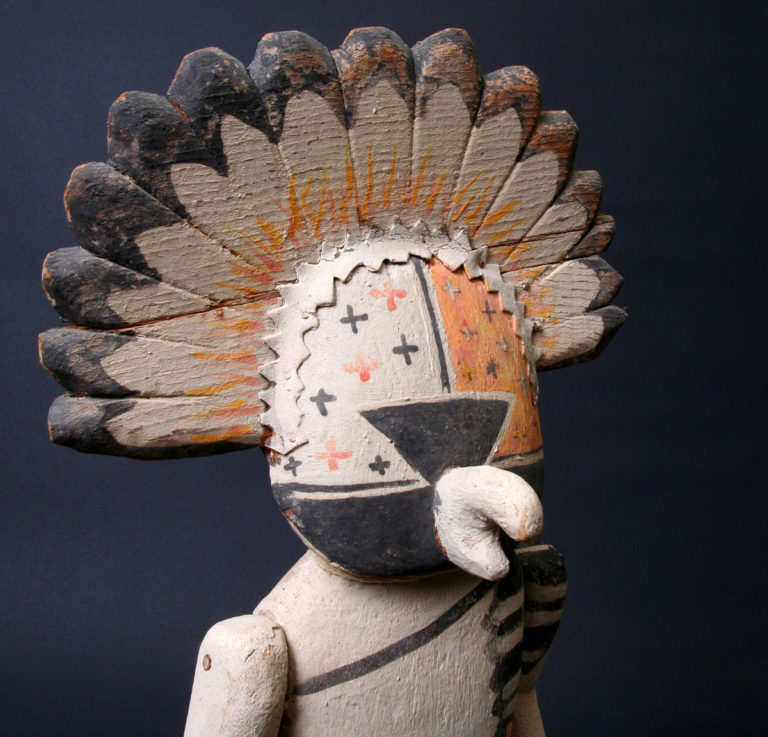Exhibits
December 10, 2024 through
November 30, 2025
America Meredith, Eric J. Kaldahl, Maria M. Martinez, Maggie Ohnesorgen Curators
Woman of Her Word: Art and Text of America Meredith
The strongest Cultural signifier of the Cherokee people is their writing system, invented by Sequoyah. The Cherokee syllabary not only conveys meaning through words but is beautiful, with its serifs, swashes, and ball terminals. Written language carries an aesthetic component, just as painted and printed images can be a visual language. America Meredith’s career dovetails visual arts and the written word. She has been a painter, printmaker, writer, and editor. This mid-career retrospective exhibition includes humble precursors to her fine art and professional writing careers. Band flyers, bike messenger t-shirts, and underground zines show the messy beginnings that led to paintings and the periodical she edits, First American Art Magazine.
Iconography informs Meredith’s oeuvre, especially religious texts in which the painting and writing embody prayers and hopes for the future. Symbols in visual arts can be “read,” such as colors laden with qualities and associated with cardinal directions. Likewise, animals and plants have associations in Cherokee culture, such as female cardinals, considered the daughters of the Sun, or Phoenix which symbolizes renewal through adversity. Humor, a fundamentally creative act, unites personal and cultural narratives, histories, and imagination.
Image: “God Gives the World to Arapaho Children” 2004, acrylic and mica on steel, 36″ x 16″ by America Meredith
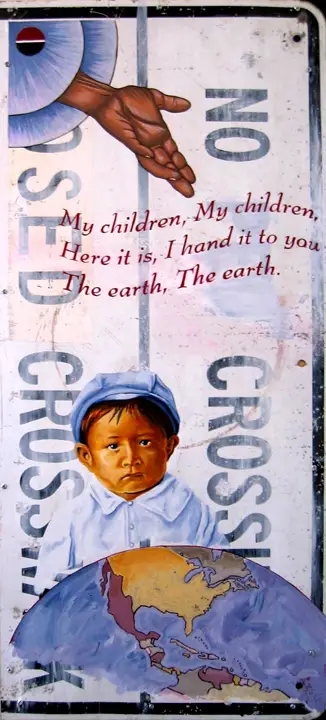
December 3, 2024 through November 30, 2025
Ryan Moreno Si'al, Maria M. Martinez, Irene Komadina, and John Miller Curators
Phantasm
Ryan Moreno Si’al is an emerging visual artist from the Tohono O’odham Nation whose unique perspective evokes phantasmic echoes of time and space. Through light and careful consideration of spatial approaches, he explores the environments people both create and destroy. He thoughtfully delves into settings with a sense of emptiness and abandonment holding space for the viewer’s own reflections.
Ryan invites his viewers to engage with his work to find personal interpretations of the images that hold stories from the past and potentialities for the future. Rooted in his cultural and personal experiences, Ryan’s artistic perspective reflects his view of the world. Growing up between Chuk-Son (Tucson) and the Tohono O’odham Nation, Ryan draws from his influences from films and music to create his art, oftentimes reflecting on the relationship between humans and the natural world.
The series “Phantasm” speaks to stories of past lives left untold. The images provoke the imagination and invite one to contemplate what was, what is now, and what is possible in crafting the future together.
Currently, Ryan continues his artistic journey in Tucson, AZ. His work can be found at Ryanmoreno.art.
Image: “Puncture” B&W Photograph, 16″ x 20″ by Ryan Moreno Si’al
June 1, 2025, through October 31, 2025
Curatorial Team: Cornelia Jensen, Greg Wallace, Denyse Fenelon (SPAP), Eric J. Kaldahl, Maria M. Martinez and Irene Komadina (Amerind), Jurors: Cody DeLong and Glenn Renell (SPAP)
The Sound of Rocks and Wind
“The Sound of Rocks and Wind,” a juried exhibition of art by the Sonoran Plein Air Painters. Representing a range of media such as oil paint, acrylic, watercolor, ink, and pastel. Celebrating the raw beauty and spirit of the Southwest, these plein air artists capture the essence of landscapes and skies, both dramatic and serene. Each artist brings a very personal vision to their understanding of the desert. From choice of scenery to execution, what we witness is a tour of places that reflect the human experience out of doors, away from the comforts of man-made environments. We need reminding that the land and sky are our mothers, where life comes from.
The Sonoran Plein Air Painters paint “en plein air,” which translates from French to “in the open air.” There is a unique challenge to painting in this way. The light is constantly shifting, the weather can present difficulties, and all materials, including easels, must be carried to and from the location. Plein air painters embrace these challenges and find joy in the experience of creating art on-site. The Sonoran Plein Air Painters seek out natural settings that offer both physical and atmospheric beauty. At times, these scenes cannot be captured by photographs in a way that conveys the full impression of being there in person. The process of studying a landscape and blending the artist’s impression with careful observation is what leads to the creation of a landscape painting. The creation becomes not only a work of art but also a memento of a fleeting moment in life.
For more information: THE SONORAN PLEIN AIR PAINTERS
Image: “Morning Vista, Kannally Ranch”, by Judith D. Johnson, oil, 20″ x 10″

October 19, 2024 through September 30, 2025
Maria M. Martinez, and Eric J. Kaldahl Curators
APACHE PRESENCE AND CONTINUITY with BASKETRY
Amerind is now exhibiting some of the most spectacular Western Apache historical/ethnographic baskets from our permanent collection. Take the opportunity to experience and see three-rod coiled shallow bowls (ts’aa’ náskadi), jars (bists’aa’á histł’oolí) and twined burden baskets (táts’aa’) and water bottles (tus) made from willow, cottonwood, devil’s claw, and yucca roots and decorated with complex design layouts of animal representations, men and women, gaan figure, crosses, triangles, and other motifs. Most of the baskets were collected between 1898 – 1918 and made their way to Amerind through a donation by collector, Charles Gilliland, Sr. Western Apache weavers created these baskets during times of colonial duress and violence, nevertheless, they express beauty, blessings, presence, continuity, and resilience.
Image: Large Historic Western Apache Basket trays, from the Amerind collection.
November 2024 through August 31, 2025
Curated and loaned from the Arizona State Museum
Our Song is Our Strength
Our Song Is Our Strength highlights the resilience and determination of the Yaqui people from their homelands near Rio Yaqui in Mexico through government enslavement and persecution, and their exodus north into the United States. As a matter of safety, their culture was kept secret until the 1970s, when after gaining federal recognition, they were allowed to freely practice, celebrate, and revitalize their traditions north of the border.
This exhibit uses original artworks from Pascua Yaqui artists to highlight issues such as United States/Mexico border wall, land and water protectors, Violence Against Women Act (VAWA), Missing and Murdered Indigenous Women (MMIW), and community pride.
Featuring the work Pascua Yaqui artists Luis Rodriguez (painter, digital art), Fransisco Fraire (painter, digital art), and Mariana Rivera (poet).
With thanks to the Arizona State Museum and the featured artists for the loan of this exhibition.
On exhibit through August 31, 2025.
Image: “Unseen,” 2023, digital painting by Fransisco Fraire, Jr.
February 14, 2023 through 2024
Eric Kaldahl, and Maria M. Martinez, Curators
Collection Spotlight:
The lindsays' wedding vases-a love story
In modern times, ceramic artists and gallery owners focused collectors’ attention on the symbolism of two spouts stemming from one reservoir of life-giving water. Today these vessels are popularly called “wedding vases.” Contemporary forms of the wedding vase have become gifts of well-wishing to couples.
For Alexander and Jane Lindsay, married in 1952, wedding vases became a frequent gift to one another on special occasions. Their four daughters also added to their collection over the years. Together for over 65 years, the couple’s collection grew to over 300 vessels, of which over 200 were gifted to the Amerind by Jane and her children. The Lindsays acquired many of the pots from Indigenous artisans, most residing in the southwestern US and northwestern Mexico. From unknown artists to very accomplished potters.
Now on exhibit are select pieces from the Lindsay family wedding vase collection, a love story for all to enjoy.
Photograph: Double-spouted olla by potter Tomasita Montoya, Ohkay Owingeh Pueblo, New Mexico.
Permanent Exhibit
Eric Kaldahl, Curator
American Art Form: A Century of A:shiwi (Zuni) and Diné (Navajo) Jewelry
Zuni and Navajo jewelers create some of the most distinctive and beautiful jewelry in the world. Amerind is the proud home of a newly donated jewelry collection built over three generations, from the late nineteenth to the late twentieth century, which includes thousands of pieces by hundreds of artists. This exhibit showcases the history and development of this jewelry and the artists who made these remarkable pieces and put their art form on the world stage.
Permanent Exhibit
Eric Kaldahl, Curator
Without Borders: The Deep History of Paquimé (Bilingual Exhibit)
Visitors can walk through this exhibit, inspired by the architecture of Paquimé, and explore sixty years of research in Chihuahua, Mexico. Paquimé was one of the most socially, politically, and ceremonially important towns in the region. It grew into a leading community in northern Mexico in the late AD 1200s and flourished through the end of the AD 1400s. Home to some of the most remarkable architecture, civil engineering, and ceramic artistry in the region—the ancient town has been designed by the United Nations as a UNESCO World Heritage Site. Partially funded by Arizona Humanities, The Robert J. Wick Family Foundation, and the Community Foundation for Southern Arizona.
Permanent Exhibit
Eric Kaldahl, Curator
Fleet of Foot: Indigenous Running and Games from Ancient Times to Today
Among all the people of the world, running and games are universal. Across cultures and traditions, sports and running are universal activities that can help us relate to one another. In the differences among our sports practices, we gain new insights into the ways of other communities. This exhibit considers running and running sports among the Indigenous communities of the southwestern US and northwestern Mexico. Partially funded by Arizona Humanities.
Permanent Exhibit
Eric Kaldahl, Curator
Indigenous Water/Ways
The Indigenous peoples of the southwestern US and northwestern Mexico treasure water in all its forms. This exhibit showcases Amerind pottery, baskets, jewelry, weavings, wood, shell, and antler carvings with water designs and motfis.Visitors will also learn about the way Indigenous farmers used water and engineered the land to nourish their crops.
Permanent Exhibit
Eric Kaldahl, Curator
A Singular Treasure: The Katsikodi Story Robe
Visitors can view an elk hide painted with scenes of hunters, singers, and dancers, created by the Eastern Shoshone artist Katsikodi. He is believed to have been born inthe 1860s and passed away around 1912. Over 20 of his distinctive painted robes have survived the forces of history, largely now preserved in museum collections like Amerind’s. Friends of Western Art supported the conservation of this elk hide.
Permanent Exhibit
Eric Kaldahl, Curator
Ma Fulton’s FF Ranch
Amerind’s founders Rose Hayden Fulton (1881-1968) and William Shirley Fulton (1880-1964) moved to Arizona in 1930. Mrs. Fulton, affectionately known as Ma Fulton, had a ranch operation where she raised and trained some of the finest quarter horses in the United States. Photographs of her horses, ranch hands, and operations are on exhibit along with her prize winning ribbons and trophies.
Permanent Exhibit
Charles Di Peso, Anne Woosley, Allan McIntyre, John Ware, Carol Charnley, and Eric Kaldahl, Curators
The Pine Study
The Pine Study was installed on the occasion of Mr. Fulton’s 80th birthday in the year 1960. The wood paneling and furnishings came from the Fulton family home in Connecticut. Many of Mr. Fulton’s personal effects are found in this exhibit. The paintings on the wall were done by family members and friends. The Pine Study served as Mr. Fulton’s office for the last years of his life.
Permanent Exhibit
John Ware and Carol Charnley, Curators
Images in Time
Built in 1939, the museum building’s main gallery houses artistic treasures created by Indigenous artists from the Arctic to Mexico. Many of the pieces were made during the late nineteenth and first half of the twentieth century. Visitors will learn about the amazing diversity of Indigenous cultures found throughout North America.
Permanent Exhibit
John Ware and Carol Charnley, Curators
Apache People and History
The Chiricahua Apache people’s history in southeastern Arizona is rich and complex. Visitors will have an overview of the many Indigenous groups who speak the Apache language, and learn about the history of the Chiricahua Apache people specifically.
Permanent Exhibit
Carol Charnley and Ron Bridgemon, Jr., Curators
The Potters of Mata Ortiz
Potters from the Mexican town of Mata Ortiz in Chihuahua, Mexico, were inspired by the ancient potters of Paquimé creating beautiful reproductions of that ancient craft. They then began new pottery traditions with finely painted and incised pottery in new shapes and styles. This exhibit shows how these potters are inspired by the past, but are creating new traditions for the future.
Permanent Exhibit
Anne Woosley and Allan McIntyre, Curators
Hallway of Time
Connecting the 1939 and 1950 wings of the Amerind museum building, this hallway lets visitors peer into the archaeology of the American Southwest. Visitors will learn about the most ancient human tools found in Arizona used some 13,000 years ago. Here to people will learn about the most well studied farming cultures of the America Southwest: Huhugam (Hohokam), Mogollon, and Ancestral Pueblo peoples. These farming communities flourished some two thousand years and their descendants still call this region home.
Permanent Exhibit
Anne Woosley and Allan McIntyre, Curators
Spanish Colonial and Mexican Religious Art
Amerind sits on land that Indigenous people have called home for 13,000 years. In historic times, the governments of Spain, Mexico, and the United States have exercised their sovereignty over the region. This exhibit displays the religious arts of colonial Spain, Mexico, and more contemporary pieces rooted in the Spanish colonial tradition.
Permanent Exhibit
Anne Woosley and Allan McIntyre, Curators
North American Indigenous Arts
The Amerind is home to the arts of Indigenous people from across North America. Now on exhibit are examples of cradleboards from many Indigenous communities. These cradleboards show the love and care of their makers for their children. Also on exhibit are personal accessories and clothing adorned with porcupine quillwork and beadwork.
Permanent Exhibit
Anne Woosley and Allan McIntyre, Curators
Yesterday's Amerind
This small enclosed room gives visitors of sense of Amerind museum history. From 1936 until the 1980s, the Amerind was closed to the public. To see its private collections, visitors had to call for an appointment. This exhibit gives today’s visitors a sense of how Amerind’s collection was displayed in the early years of our museum’s history.

